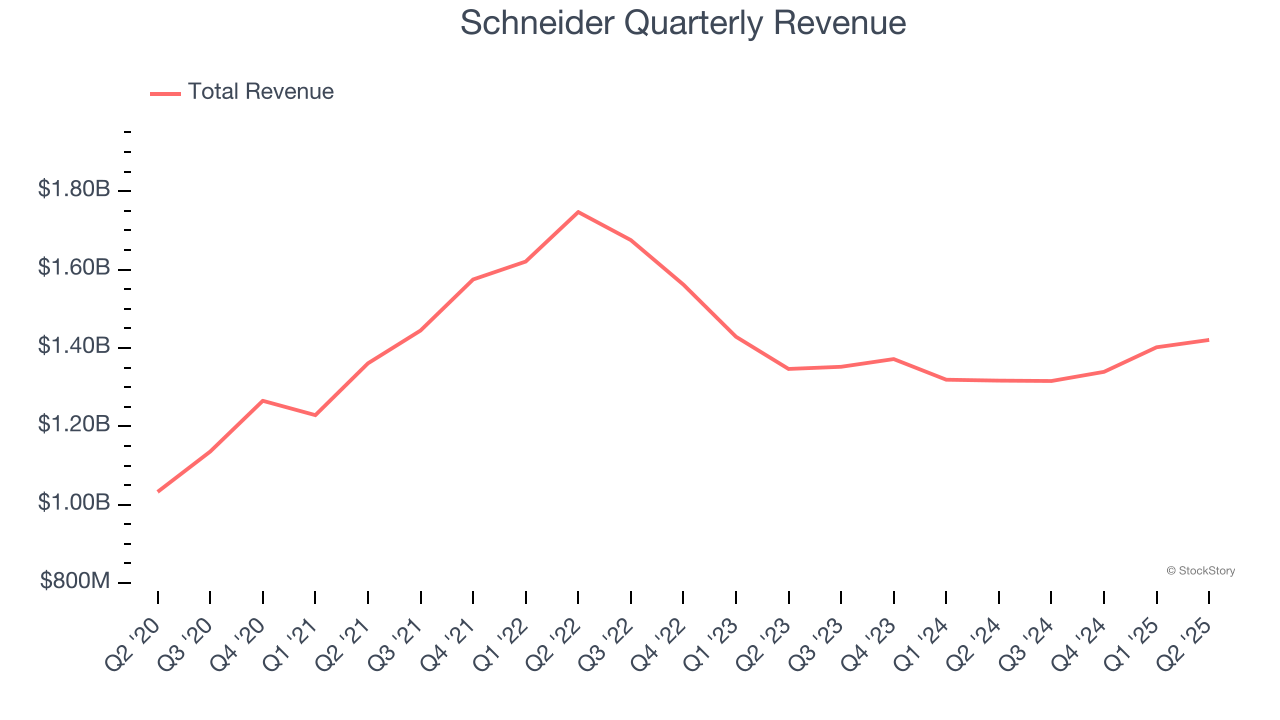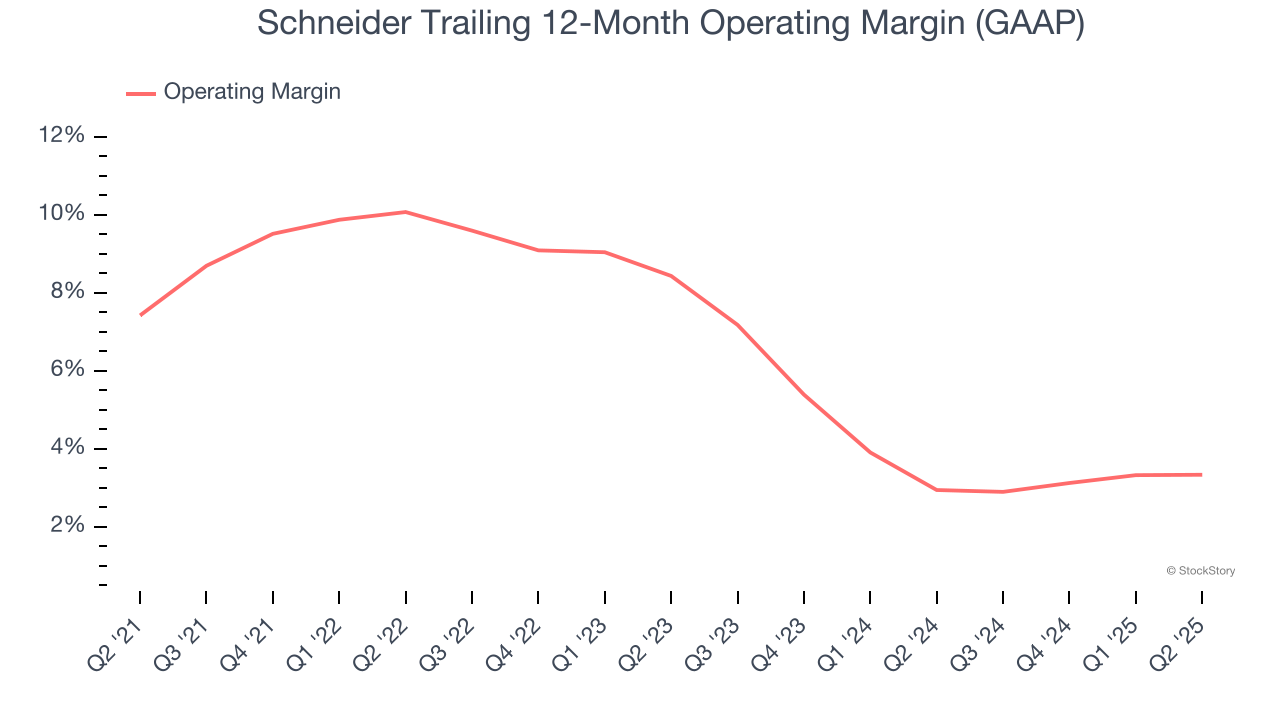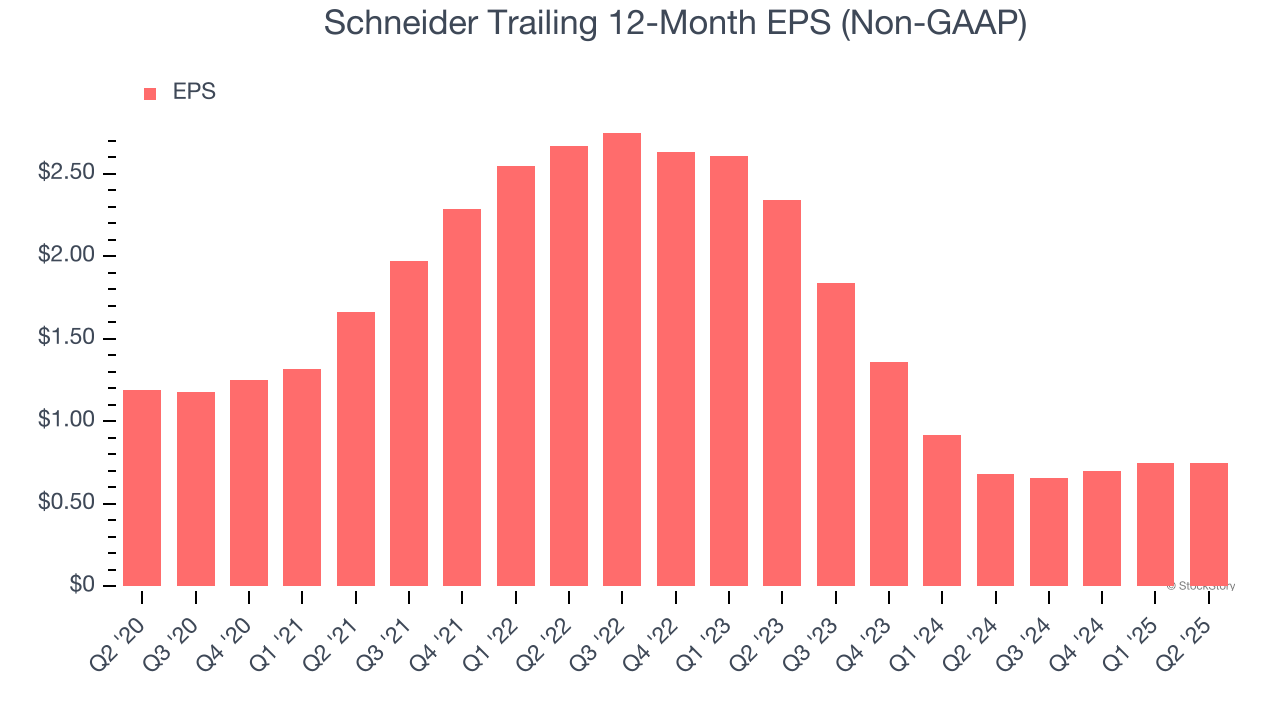
Transportation company Schneider (NYSE: SNDR) reported Q2 CY2025 results topping the market’s revenue expectations, with sales up 7.9% year on year to $1.42 billion. Its non-GAAP profit of $0.21 per share was in line with analysts’ consensus estimates.
Is now the time to buy Schneider? Find out by accessing our full research report, it’s free.
Schneider (SNDR) Q2 CY2025 Highlights:
- Revenue: $1.42 billion vs analyst estimates of $1.41 billion (7.9% year-on-year growth, 0.7% beat)
- Adjusted EPS: $0.21 vs analyst estimates of $0.20 (in line)
- Adjusted EBITDA: $166.3 million vs analyst estimates of $165.9 million (11.7% margin, in line)
- Management lowered its full-year Adjusted EPS guidance to $0.85 at the midpoint, a 2.9% decrease
- Operating Margin: 3.9%, in line with the same quarter last year
- Free Cash Flow Margin: 8.7%, similar to the same quarter last year
- Market Capitalization: $4.29 billion
“We delivered another quarter of earnings growth driven by solid execution, particularly in our Truckload and Intermodal segments. The second quarter saw consistent demand trends with some seasonal patterns emerging, though less pronounced than usual, despite ongoing economic uncertainty,” said Mark Rourke, President and Chief Executive Officer of Schneider.
Company Overview
Employing thousands of drivers across the country to make deliveries, Schneider (NYSE: SNDR) makes full truckload and intermodal deliveries regionally and across borders.
Revenue Growth
Reviewing a company’s long-term sales performance reveals insights into its quality. Even a bad business can shine for one or two quarters, but a top-tier one grows for years. Regrettably, Schneider’s sales grew at a sluggish 4% compounded annual growth rate over the last five years. This fell short of our benchmark for the industrials sector and is a rough starting point for our analysis.

We at StockStory place the most emphasis on long-term growth, but within industrials, a half-decade historical view may miss cycles, industry trends, or a company capitalizing on catalysts such as a new contract win or a successful product line. Schneider’s performance shows it grew in the past but relinquished its gains over the last two years, as its revenue fell by 4.6% annually. Schneider isn’t alone in its struggles as the Ground Transportation industry experienced a cyclical downturn, with many similar businesses observing lower sales at this time. 
Schneider also breaks out the revenue for its most important segments, Truckload and Logistics, which are 43.8% and 23.9% of revenue. Over the last two years, Schneider’s Truckload revenue (road freight) averaged 3.3% year-on-year growth. On the other hand, its Logistics revenue (supply chain, warehousing) averaged 9% declines.
This quarter, Schneider reported year-on-year revenue growth of 7.9%, and its $1.42 billion of revenue exceeded Wall Street’s estimates by 0.7%.
Looking ahead, sell-side analysts expect revenue to grow 7.1% over the next 12 months. Although this projection implies its newer products and services will spur better top-line performance, it is still below average for the sector.
Today’s young investors won’t have read the timeless lessons in Gorilla Game: Picking Winners In High Technology because it was written more than 20 years ago when Microsoft and Apple were first establishing their supremacy. But if we apply the same principles, then enterprise software stocks leveraging their own generative AI capabilities may well be the Gorillas of the future. So, in that spirit, we are excited to present our Special Free Report on a profitable, fast-growing enterprise software stock that is already riding the automation wave and looking to catch the generative AI next.
Operating Margin
Operating margin is one of the best measures of profitability because it tells us how much money a company takes home after procuring and manufacturing its products, marketing and selling those products, and most importantly, keeping them relevant through research and development.
Schneider was profitable over the last five years but held back by its large cost base. Its average operating margin of 6.6% was weak for an industrials business. This result isn’t too surprising given its low gross margin as a starting point.
Looking at the trend in its profitability, Schneider’s operating margin decreased by 4.1 percentage points over the last five years. This raises questions about the company’s expense base because its revenue growth should have given it leverage on its fixed costs, resulting in better economies of scale and profitability. We’ve noticed many Ground Transportation companies also saw their margins fall (along with revenue, as mentioned above) because the cycle turned in the wrong direction, but Schneider’s performance was poor no matter how you look at it. It shows that costs were rising and it couldn’t pass them onto its customers.

This quarter, Schneider generated an operating margin profit margin of 3.9%, in line with the same quarter last year. This indicates the company’s cost structure has recently been stable.
Earnings Per Share
Revenue trends explain a company’s historical growth, but the long-term change in earnings per share (EPS) points to the profitability of that growth – for example, a company could inflate its sales through excessive spending on advertising and promotions.
Sadly for Schneider, its EPS declined by 8.8% annually over the last five years while its revenue grew by 4%. This tells us the company became less profitable on a per-share basis as it expanded due to non-fundamental factors such as interest expenses and taxes.

We can take a deeper look into Schneider’s earnings to better understand the drivers of its performance. As we mentioned earlier, Schneider’s operating margin was flat this quarter but declined by 4.1 percentage points over the last five years. This was the most relevant factor (aside from the revenue impact) behind its lower earnings; interest expenses and taxes can also affect EPS but don’t tell us as much about a company’s fundamentals.
Like with revenue, we analyze EPS over a more recent period because it can provide insight into an emerging theme or development for the business.
For Schneider, its two-year annual EPS declines of 43.4% show it’s continued to underperform. These results were bad no matter how you slice the data.
In Q2, Schneider reported adjusted EPS at $0.21, in line with the same quarter last year. This print beat analysts’ estimates by 3.9%. Over the next 12 months, Wall Street expects Schneider’s full-year EPS of $0.75 to grow 45.1%.
Key Takeaways from Schneider’s Q2 Results
It was good to see Schneider provide full-year EPS guidance that slightly beat analysts’ expectations. We were also happy its revenue narrowly outperformed Wall Street’s estimates. Overall, this print had some positives. The stock remained flat at $24.46 immediately following the results.
Is Schneider an attractive investment opportunity right now? What happened in the latest quarter matters, but not as much as longer-term business quality and valuation, when deciding whether to invest in this stock. We cover that in our actionable full research report which you can read here, it’s free.




